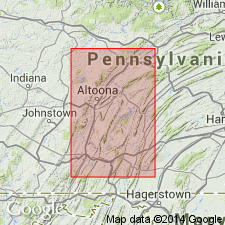
- Usage in publication:
-
- Centennial School member
- Modifications:
-
- Named
- Dominant lithology:
-
- Sandstone
- Shale
- AAPG geologic province:
-
- Appalachian basin
Summary:
Named the Centennial School sandstone and shale member of the Bald Eagle sandstone in central PA. Unit is lower member of formation in Tyrone Gap area. Overlies Reedsville shale and underlies Spring Mount sandstone member.
Source: GNU records (USGS DDS-6; Reston GNULEX).

- Usage in publication:
-
- Centennial School Member
- Modifications:
-
- Not used
- AAPG geologic province:
-
- Appalachian basin
Summary:
Attempts to apply member status to subdivisions of drab Bald Eagle and red Juniata Formations reveal inconsistencies. Thicknesses of Centennial School and Spring Mount Members of Eagle Formation and East Waterford Member of Juniata Formation fluctuate considerably and randomly in very short geographic distances. In addition, at several locations, drab shale is found above the massive sandstones of Spring Mount Member. They are not assignable to Spring Mount Member on lithologic basis, but they are not red so they cannot be assigned to Juniata either. Similarly, red sandstones and shales are found beneath East Waterford Member. They are not East Waterford lithology, but they cannot be assigned to Bald Eagle because of color. Proposal is to do away with formal member names and switch to lithofacies nomenclature for subdivisions of these formation. [Centennial School Member is not formally abandoned in this report.]
Source: GNU records (USGS DDS-6; Reston GNULEX).
For more information, please contact Nancy Stamm, Geologic Names Committee Secretary.
Asterisk (*) indicates published by U.S. Geological Survey authors.
"No current usage" (†) implies that a name has been abandoned or has fallen into disuse. Former usage and, if known, replacement name given in parentheses ( ).
Slash (/) indicates name conflicts with nomenclatural guidelines (CSN, 1933; ACSN, 1961, 1970; NACSN, 1983, 2005, 2021). May be explained within brackets ([ ]).

